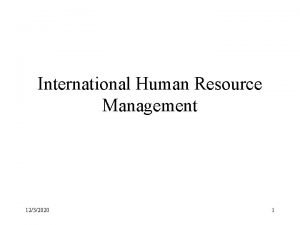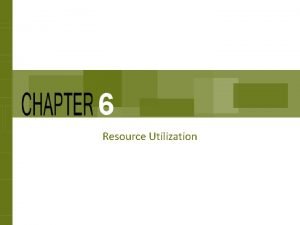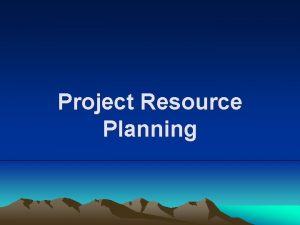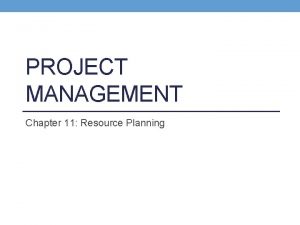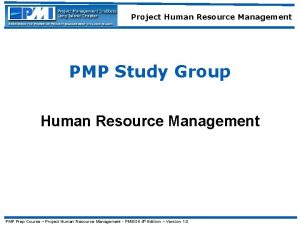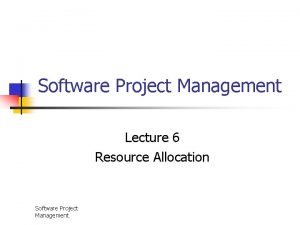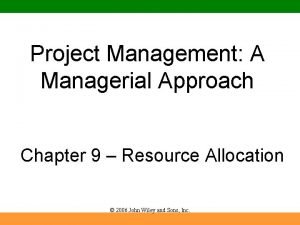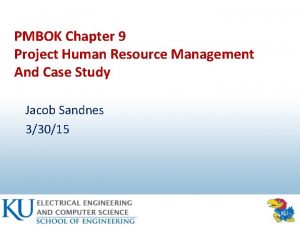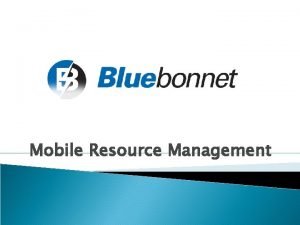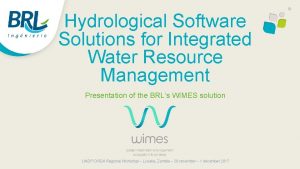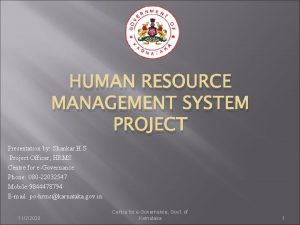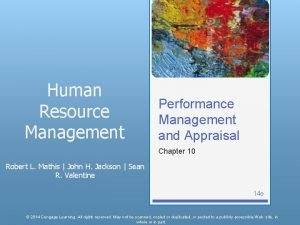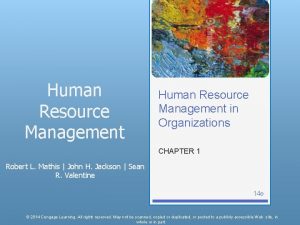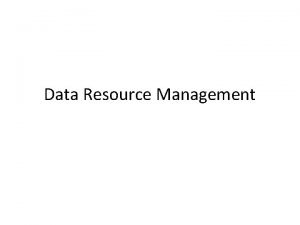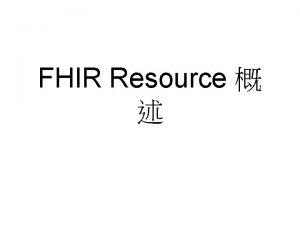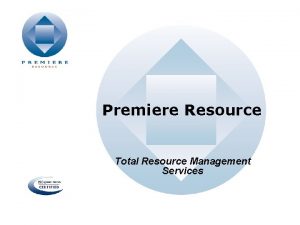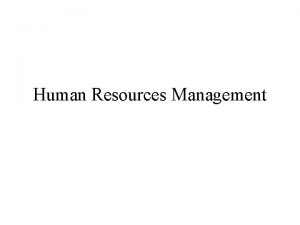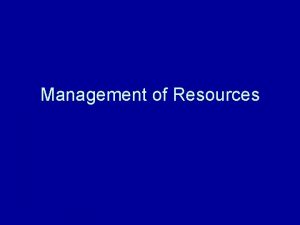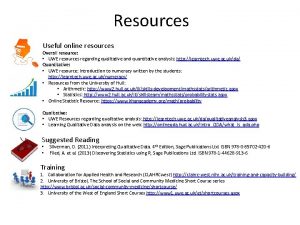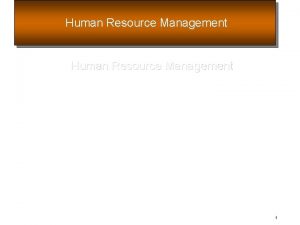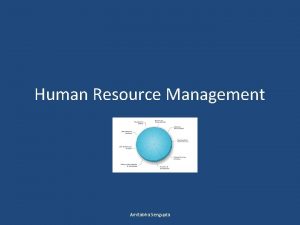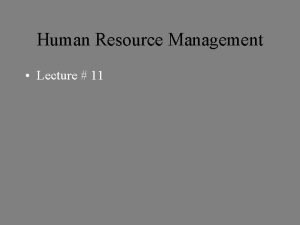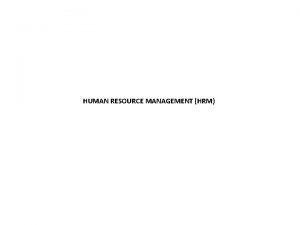Resources Management Outline Definition of Resources Resource AggregationLoading



































- Slides: 35

Resources Management

Outline • • • Definition of Resources Resource Aggregation/Loading Problems Associated with Resource Leveling Resource Scheduling

What a resource? • Any thing that is used by an activity to get the work done, such as: Material, Equipment, Labor, Money, …. .

Resources Classification • Resources can be: – Consumable (Money, Material, ……) – Non Consumable (Labor, Equipment, …) • Resources can be: – Key or constrained resources (Skilled labor, Equipment, ……) – Secondary or non-constrained resources (Labor, …) – General resources, used by all activities

Duration-Driven Schedule • All CPM scheduling techniques are duration driven schedules – Basic units: activities, durations, relationships – Assumes resources are available whenever needed • Difference between: – Working dates – Calendar dates

Optimum Resource Usage • Need of resource is fixed along the project construction time • Impossible to achieve because of activities overlap • Work volume = Area = resource units x time – Resource demand – Resource available

Resource Histogram • Graphically represents resource needs • Relation between resource units and time • Procedure: – Draw the network – Draw the bar chart – Determine the points where activities start and/or finish.

Preferred Resource Usage

Resource Aggregation/Loading • The summation, on a period-by-period basis, of the resources required to complete all activities based on the schedule carried out in the previous stage • The results are usually shown graphically as a histogram • A separate graph will be required for each resource

Resource Aggregation/Loading – Consider the following activities – Resource limit = 10 units /week Activity Duration (week) Resources (units/week) A B C D E 2 3 2 5 2 Shown in the histogram

Resource Aggregation/Loading Resource Limit

Problems Associated with Resource Fluctuation (Resource leveling) Resource Over allocation (Resource Scheduling) High hiring and firing Less hiring and firing

Resource Leveling (Smoothing) Unconstrained resource scheduling (Constrained time) Resource Leveling • Resource unconstrained (No limits on resources) • Time (Project completion) constrained; project duration not be delayed • Reduce the difference between the peaks and the valleys • Average resource usage • The objective is to smooth the use of the resources to avoid the resource fluctuation

Resource Leveling (Smoothing)

Resource Leveling (Smoothing)

Resource Leveling (Smoothing) Heuristic Method Procedure – Prepare a complete activity schedule – Draw a bar chart based on ES timings – Draw the FF as dashed line beside the upper side of the bar and the TF beside the lower side – Put the resource usage in each bar of the related activity – Critical activities to be drawn first (do not move them) – Aggregate the resources in each time period

Resource Leveling (Smoothing) Heuristic Method Procedure – Calculate the total usage of resources = Σ unit period usage – Calculate the average resource usage = Σ usage / utilization period – Shift non-critical activities within their FF first, then their TF to decrease the peaks and raise the valleys – Revise the activities float – Aggregate the resources in each time period

Resource Leveling (Example) Activity Duration (Weeks) Predecessors Resource (units/week) A B C D E F G H I J K L M N 0 2 5 3 2 6 6 6 4 2 7 3 2 2 1 1 1 2 2 3 4 4 5, 6 6, 7 2, 8, 9 10, 11, 12, 13 0 0 2 2 1 2 3 1 0 4 2 2 4 0

Resource Leveling (Example)

Resource Leveling (Example) Activity ES EF FF TF A B C D E F G H I J K L M N 0 0 2 2 5 3 3 8 11 9 9 18 0 2 5 3 4 8 11 9 7 10 18 12 11 20 0 0 4 0 0 0 2 8 0 6 7 0 0 3 0 6 12 3 0 6 9 8 0 6 7 0

Resource Leveling (Example)

Resource Leveling (Example)

Resource Leveling (Example)

Resource Leveling (Example)

Resource Leveling (Example)

Resource Scheduling • Constrained resource scheduling (Unconstrained time) • Resource Scheduling – Constrained Resources – Unconstrained project completion; project time may be delayed – Reduce the resource usage to be less than the resource availability – The objective is to meet the resources limits

Resource Scheduling

Resource Scheduling Is there is a way to prioritize activities That compete for the limited resources so that the net project delay is minimized?

Resource Scheduling Rules of Thumb – Many rules have been experimented with – Least TF were found to be most effective – Least LS has the same effect as the least TF and doesn’t require network recalculations – In case of a tie use least TF

Resource Scheduling Procedure – Prepare a complete activity schedule – Aggregate the daily resource demand – If demand greater than available then determine activities compete for resources – Prioritize these activities based on their LS – Allocate resources to some activities and delay the others – Put your solution in table format

Resource Scheduling (Example) Activity A B C D E F G H I J K Duration (Weeks) Predecessors 6 4 2 8 4 10 16 8 6 6 10 A D B B F E, H C G, J Resource (units/week) R 1≤ 8 R 2≤ 1 3 6 4 0 4 2 4 5 2 0 1 1 1 0 0 1 1 0

Resource Scheduling (Example)

Resource Scheduling (Example)

Resource Scheduling (Example)

QUESTIONS Contact: Dr. Ahmed Elyamany 019 -4100 -824 a 2 hyamany@yahoo. com
 Resource leveling is the approach to even out the peaks of
Resource leveling is the approach to even out the peaks of Perbedaan antara resource loading dan resource levelling
Perbedaan antara resource loading dan resource levelling Time management in human resource management
Time management in human resource management Hrm in retail
Hrm in retail Literal sense in hrm
Literal sense in hrm Example of topic outline and sentence outline
Example of topic outline and sentence outline International human resource management definition
International human resource management definition A c f h k
A c f h k Concept of hrm
Concept of hrm Human resources defintion
Human resources defintion Resource loading definition
Resource loading definition Resource planning definition in project management
Resource planning definition in project management Project management human resources
Project management human resources Human resources cafs
Human resources cafs Types of family resources
Types of family resources Difference between transforming and transformed resources
Difference between transforming and transformed resources Fixed resources and variable resources
Fixed resources and variable resources Renewable vs nonrenewable resources worksheet
Renewable vs nonrenewable resources worksheet Storage resource management tools
Storage resource management tools Allocation management software
Allocation management software Office 365 resource management
Office 365 resource management Resource levelling in project management
Resource levelling in project management Project human resource management pmbok ppt
Project human resource management pmbok ppt Pmbok human resource management
Pmbok human resource management Mobile resource management solutions
Mobile resource management solutions Mba meaning college
Mba meaning college Restaurant human resources
Restaurant human resources Induction in hrm
Induction in hrm Water resource management software
Water resource management software Chapter 2 human resource management
Chapter 2 human resource management Chapter 9 human resource management
Chapter 9 human resource management Human resource management system project ppt
Human resource management system project ppt Mbo performance appraisal method
Mbo performance appraisal method Current issues in human resource management
Current issues in human resource management Ba human resource management
Ba human resource management Acas discrimination
Acas discrimination






